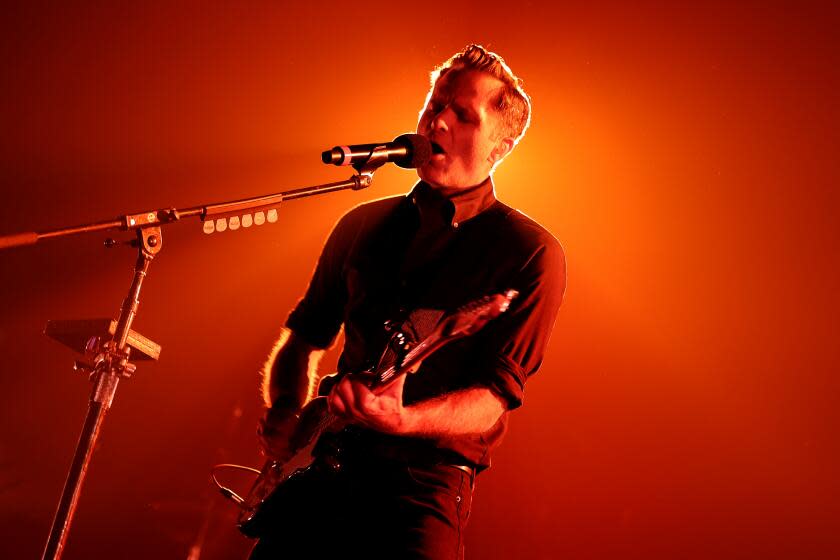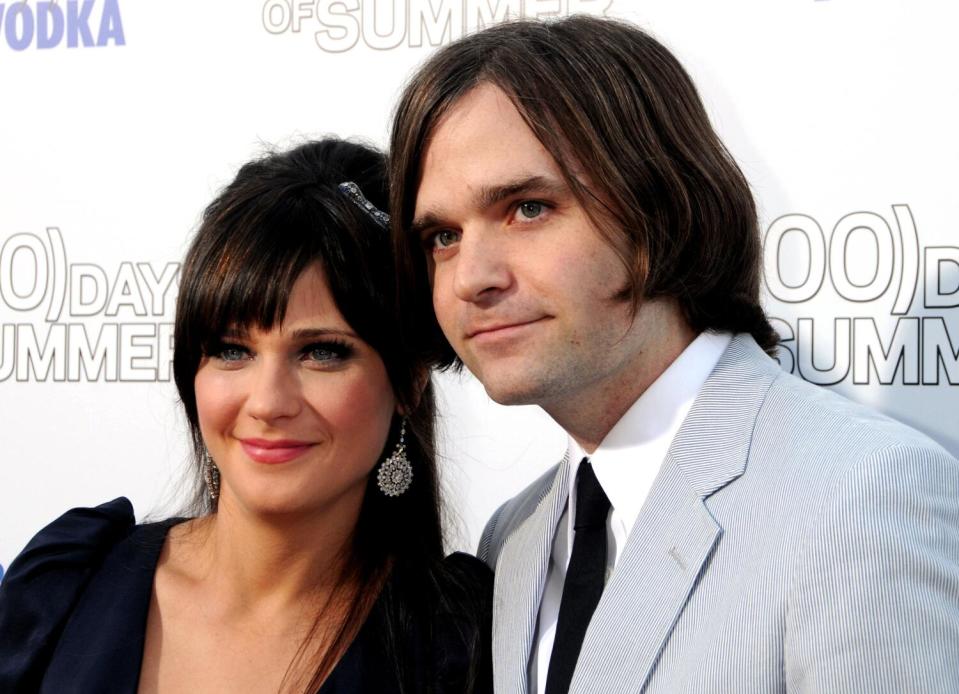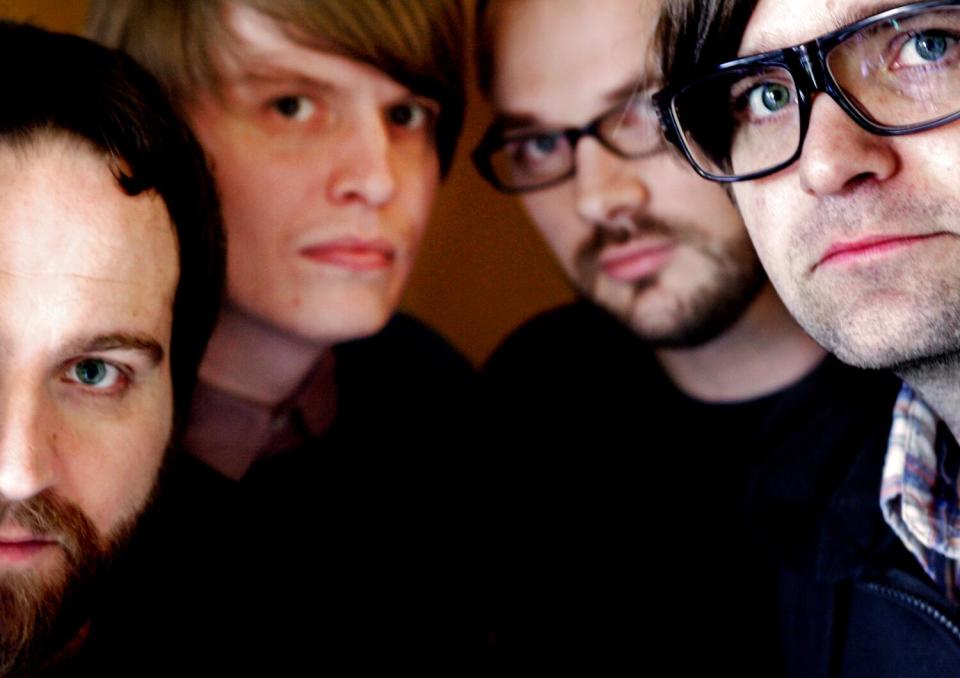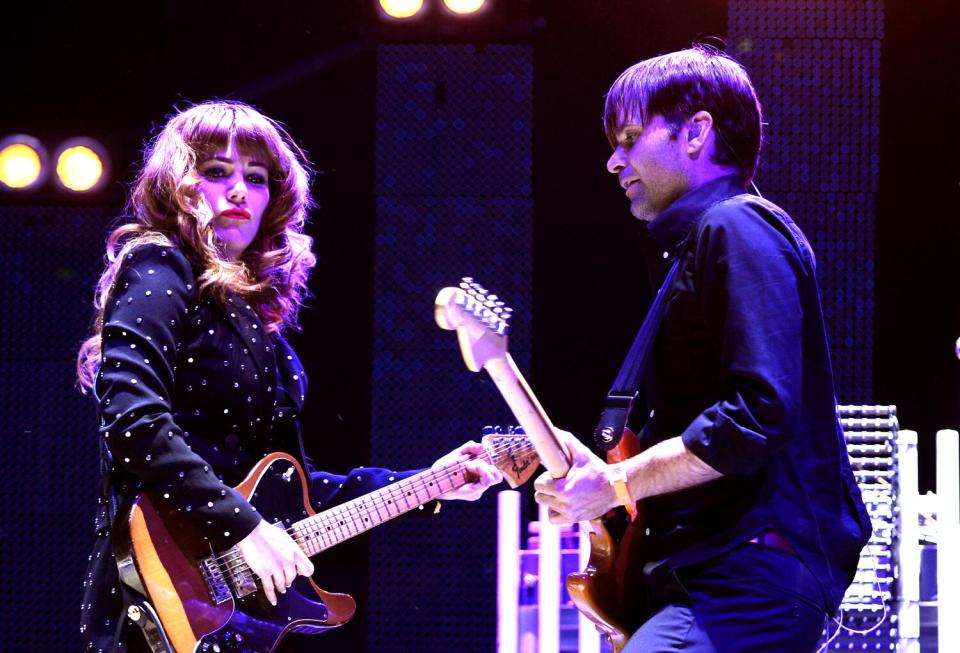Ben Gibbard on his love-hate relationship with L.A. and life after the Postal Service

Twenty-one years ago, Ben Gibbard’s life changed twice in the span of eight months.
In February 2003, the frontman of Seattle’s Death Cab for Cutie released “Give Up,” the first (and only) album by his electro-pop side project the Postal Service; it went on to become an indie blockbuster, selling more than a million copies and spawning swoony millennial anthems like “Such Great Heights.” Gibbard doubled down in October of that year with Death Cab’s even swoonier “Transatlanticism,” which led to the band’s appearance on the hit teen soap “The O.C.” and a major-label deal with Atlantic Records.
Last fall, Death Cab and the Postal Service marked the 20th anniversary of both LPs with a tour on which each act performed its signature work from beginning to end. (Gibbard, an experienced long-distance runner, has joked about the no-big-deal endurance required to play two 45-minute albums in one evening.) Like “Give Up” and “Transatlanticism,” the road show was a hit, filling arenas and amphitheaters including Madison Square Garden and the Hollywood Bowl. Now the groups are set to take a victory lap with performances at Saturday’s Just Like Heaven festival in Pasadena.
For Gibbard, 47, the show marks a return to familiar ground: He formed the Postal Service with a pair of Angelenos: producer Jimmy Tamborello and singer Jenny Lewis of L.A.’s Rilo Kiley. “Transatlanticism,” meanwhile, describes a fling with a woman in Silver Lake and followed Death Cab’s 2001 “The Photo Album,” on which Gibbard asks someone why they’d want to live in a town that “smells like an airport runway.” (The frontman later moved to L.A. during his three-year marriage to actor Zooey Deschanel, whom he divorced in 2012.)
Gibbard talked to The Times about the albums — as well as the state of indie rock and his friendship with former Death Cab guitarist Chris Walla, who quit the band in 2014 — before a gig last week in Kansas City, where he’d just spent the day visiting the Negro Leagues Baseball Museum and the American Jazz Museum. “There’s only so many Ernest movies you can watch on tour,” he said with a laugh of the cultural enrichment. “At a certain point you gotta up it a bit.”
Is the relationship you’re singing about in Death Cab’s “Tiny Vessels” — the girl in Silver Lake with the light brown streaks in her hair — the same relationship that had earlier inspired “Why You’d Want to Live Here”?
No. “Why You’d Want to Live Here” is kind of a stand-alone piece of fiction. And the mentions of Silver Lake on “Transatlanticism” are specific to a relationship that’s not really central to the album.
So why identify Silver Lake by name?
Well, “Transatlanticism” wasn’t conceived as a concept record — it wasn’t written about one person, despite the legend that’s kind of grown up around it. The songs span from like August 2001 to the spring of 2003, and there was a lot happening in my life at that point: I’d moved to Seattle to live with someone in my first real adult relationship, and then that person moved back to the East Coast and I was kind of floating for a year and a half through false starts of relationships — just feeling that general mid-20s malaise, trying to figure my s— out. But I’d rather allow people their fantasies than go song by song telling them they’re wrong.
Read more: Weezer's Blue Album at 30: The inside story of the debut that launched L.A.'s nerdiest band
Rolling Stone described “Transatlanticism” in 2003 as “11 indie lullabies … ostensibly about a long distance relationship.”
I think a lot of it has to do with Chris’ production. Because we’ve been playing the record in order with the transitions and everything, I’ve really been living with it for the first time in 20 years. And there’s this three-song sequence — “Tiny Vessels” into “Transatlanticism” into “Passenger Seat” — where Chris did such a brilliant job of sonically connecting them that it kind of gives the listener the impression that the subject matter is related to the same person or the same situation.
“Give Up” was framed with this idea that you and Jimmy were sending music back and forth through the mail. But how significant was the time you spent working on the album in L.A.?
Crucial. L.A.’s where I first met Jenny Lewis. I just emailed her out of the blue because Rilo Kiley was on [Death Cab’s label] Barsuk and I liked her voice. She picked me up at the Burbank airport and we got Mexican food and then went to Jimmy’s house and started making the record. It feels like the kind of thing that would never happen today. But in your 20s you’re like, “Something’s going on? I’ll do it. I don’t need to know if there’s parking.”
You sing about L.A. in a pretty negative way on Death Cab’s “Kintsugi,” which followed your divorce.
“Kintsugi” is not necessarily an indictment of L.A. — it’s an indictment of the entertainment industry that I’d found myself rubbing up against. Whereas my experience making “Give Up” with Jimmy and Jenny was hanging out with their friends and recognizing that there were a lot of really interesting creative people doing cool things in the underground that weren’t directly tied to Hollywood. Los Angeles has been a character in so much of my music because I’m both attracted and repulsed by it.

Where in town did you and your ex-wife live?
We lived initially in a duplex a couple blocks off La Brea — the Orthodox part of Hancock Park before it starts getting really fancy. Then we bought a house in the Cahuenga Pass, which looking back wasn’t somewhere I particularly liked living. As people do in relationships, I made a very hasty leap not only into that relationship but into a totally different city that I didn’t know. When I moved back to Seattle, kind of battered with my tail between my legs, I was like, “I’m never f—ing leaving this place ever again.”
Are there certain areas here that you avoid now?
There aren’t really. When we were rehearsing for this tour [in L.A.] last August, I went on a run one day and took this big loop through Hancock Park. My path went by our old place, and it was just: “Ah, I used to live there. Moving on.”
How big had “Give Up” become by the time “Transatlanticism” came out?
I don’t know how many copies it had sold but I think it was over 100 or 200,000. That was a fairly tense time because this little side project had completely outsold “The Photo Album” like three to four times over. I’m not sitting here 20 years later saying I wasn’t able to enjoy it as much I wanted to — nobody in Death Cab made me feel that way. But it was weird for the other guys: We’re going out on tour, and people are yelling Postal Service songs at us because at that point the Postal Service was bigger than Death Cab for Cutie.
In a sense that’s still true. The Postal Service is billed higher than Death Cab at Just Like Heaven.
As well it should be. It’s an issue of scarcity: When the Pixies came back after not playing a show for 10 or 15 years, they were playing venues way bigger than the places they played when they were actually a band. So of course the Postal Service is gonna headline the show. We sold 13,000 seats in Toronto a couple nights ago. The last time Death Cab played Toronto, we played Massey Hall, which is like 2,800 people. We all know what’s driving these tickets.

Has the strong reception made you think about what audiences are responding to?
Absolutely. Music is a time machine — more than any other art form, it has this ability to take us back to a time in our lives. I remember coming home from college and my dad was playing me some records. He played “The Freewheelin’ Bob Dylan,” and it got to “Girl From the North Country” and he had his hand over his face — I knew he was listening to this song, thinking about a woman that wasn’t my mom. That’s just what music does.
So when I had the idea to do this tour, I felt like we almost had an obligation to do it because of how much these two records mean to people. And because there’s not another artist or band or collection of people that could. I don’t mean that in a self-aggrandizing way. If you can name another artist who had two records like this in the course of one calendar year, by all means tell me.
Even so, has the reaction surprised you?
It was the additional nights that were humbling: adding a second Hollywood Bowl, a third Hollywood Bowl, a second Madison Square Garden. I knew that people had relationships with these records, but I had no idea that this many people did.
This tour’s really changed me as far as how I move forward, not necessarily as a writer but as a performer. Before this tour, my performances were physical but kind of internal — I’m up there playing my guitar, I’m talking a bit, but I’ve never performed to the crowd. Now, for whatever reason — maybe because I’m standing next to Jenny Lewis, who’s one of the most amazing performers we have — it’s given me the confidence to look people in the eyes, to move toward the front of the stage rather than staying toward the back. A little less Stephen Malkmus, a little more Bono.

At some point before the tour you got a real glow-up of a haircut.
I went to the woman who cuts my hair and said, “I’ve had bangs for 25 years — I gotta make a change.” But there might be something to not performing with a mess of hair in my face all the time. It’s nice when you have friends text you photos or Twitter posts saying nice things about how you look — certainly helps build your confidence.
Your voice in these shows is almost eerily unchanged from the records. It doesn’t sound like you’re having much trouble singing this old music.
I’ve been blessed with pretty good genetics. But I’ve spent the better part of the last 15 years being very cognizant of what I put in my body. Knock on wood that it remains so, but if you’re not smoking or drinking, and you’re physically fit, it’s actually easier now.
You ever worry that the boyishness of your voice will start to feel emotionally inappropriate for your age?
There’s the tone of the voice and then what the voice is singing, right? Playing songs you wrote when you were 21 or 22 when you’re 47 or 50 — there’s a lot of life between those ages. But I think as a concertgoer you just kind of know that’s the case. I saw the Cure last year — one of my top three bands of all time — and there’s Robert Smith singing “Boys Don’t Cry.” I think I’d feel more self-conscious about it if I wasn’t also writing songs from the perspective of a 47-year-old man.
As far as the tone goes, I’m a little cringey when I hear how boyish I sound on the old records. No one’s ever gonna consider my voice masculine, but it has a little bit of a patina on it now — a little bit grittier, a little more heft to it.
How would you describe your relationship with Chris Walla at the moment?
We just texted yesterday about Steve Albini. Chris and I had some rough patches after he left — he was very upset about some things I said specifically to you. And, you know, I stand by what I was trying to say, though I probably could have said it better. But he’s in Norway with his wife and a kid, and he’s making records and living the life he wants to live. His influence on my life, both as a human being and as a creative person, can’t be overstated. But sometimes what’s best for somebody you love is not necessarily for them to stay with you.
Was Albini important to you?
I think he was important to everybody in our world. But for Chris specifically, I remember he had this Shellac 7-inch where the insert was like their recording setup, with a drawing of every microphone and every compressor. The takeaway was: Get this stuff, and you can do this too. That was such an important message to receive, certainly for Chris — the idea that you don’t have to wait around for a major label to find you and put you in the studio. You can just start making recordings yourself. All of the schematics and photos that Albini was willingly putting out in the world, not caring whether anybody was gonna quote-unquote steal his sound — that was part of the DNA of our first few albums.
Read more: How Steve Albini changed rock music, in 12 essential songs
The era of those albums — the era this tour looks back on — was a fruitful one for white dudes writing indie rock songs. Two decades later, most of the energy in indie rock is with young women.
White male voices dominated rock ’n’ roll from the jump until, like, five years ago. We had a pretty good run [Laughs]. No one is sitting here saying, “I really want to know what a 25-year-old white guy has to say on this topic.” We already know! I think one of the wonderful things about the world we’re living in these days — and contrary to popular belief, there are some wonderful things — is that voices that maybe once were very much kept to the fringe are now finding an audience.
I’m gonna go off on this for a bit, if you don’t mind. Basically, in the early aughts, with the rise of indie rock, there were a lot of straight white men who were making music that was fine — not unique, not particularly interesting, but it was fine. And I’ve seen a number of people — my friends — who’ve kind of fallen on hard times. And while I feel bad for them, I’d rather live in a world where being a straight white guy is not enough. You actually have to be really f—ing talented.
I feel horrible saying this. But people don’t have to listen to you anymore. They can find something that speaks to them as a queer person or as a person of color. We’ve experienced this ourselves with putting out new records. We put out records and they don’t have the impact they once had for a number of reasons. But one of them, which is entirely justifiable, is that people have more options now. They don’t need my perspective on things.
With that in mind: Drake or Kendrick Lamar?
Oh, Kendrick all the way. You gotta be out of your damn mind to go toe to toe with that guy.
This story originally appeared in Los Angeles Times.
